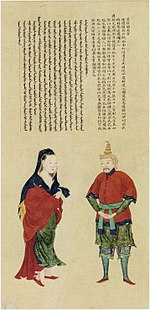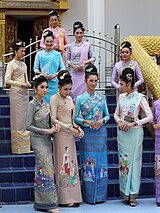Traditional Thai clothing

Traditional Thai clothing (
History

Historically, both Thai males and females dressed themselves with a loincloth wrap called
Prior to the 1700s, Thai men and women both kept their hair long. However, following the
From the 1860s onward, Thai royals "selectively adopted Victorian corporeal and sartorial etiquette to fashion modern personas that were publicized domestically and internationally by means of mechanically reproduced images."[3] Stitched clothing, including court attire and ceremonial uniforms, were invented during the reign of King Chulalongkorn.[3] Western forms of dress became popular among urbanites in Bangkok during this period.[3] During the early–1900s, King Chulalongkorn encouraged Thai women to wear long hair instead of traditional short hair which later became a trend during the reign of King Vajiravudh along with wearing pha sin (ผ้าซิ่น), a tubular skirt, instead of the chong kraben (โจงกระเบน), a cloth wrap.[5]
On 15 January 1941,
Traditional costumes
Chong kraben
Chong kraben or Sompot Chong Kben (Thai: โจงกระเบน Thai pronunciation: [tɕoːŋ.kra.beːn]) is a lower-body, wraparound cloth. It is synonymous with the Khmer sampot. The sampot is a long, rectangular cloth worn around the lower body. The traditional dress is similar to the dhoti of South Asia. The chong kraben resembles pants more than skirts. It is a rectangular piece of cloth measuring three meters long and one meter wide. It is worn by wrapping around the waist, stretching it away from the body, twisting the ends together then pulling the twisted fabric between the legs and tucking it in the back of the waist.
Pha nung

The pha nung (Thai: ผ้านุ่ง), also known as pha sin (Thai: ผ้าซิ่น) or pha thung (Thai: ผ้าถุง), is a long fabric worn around the waist that resembles a long skirt.[7] [8]

Sabai

Sabai (
Suea pat
Suea pat (Thai: เสื้อปัด Thai pronunciation: [sɯ̂a.pàt]) is a long-sleeved shirt with no buttons. It is worn by wrapping the right side of the front panel of the shirt over the left side of the front panel, and the two panels are tied together via strings. Suea pats are typically worn by northern Thai women
Raj pattern
Raj pattern refers either to a
Pha khao ma
Pha khao ma (Thai: ผ้าขาวม้า Thai pronunciation: [pʰâː kʰǎw máː])) is a versatile plaid fabric woven for centuries in Thailand. It serves numerous purposes, including being worn as a waistband by Thai men, used as a handkerchief, fan, or head covering to protect against the sun, and even used as a makeshift cradle or to carry goods. The cloth's practicality and sustainability have attracted the attention of designers in the fashion and interior design industries.[9] The word Khao ma is derived from the Persian word Kamarband, meaning waistband or belt.[10] This cloth has become an omnipresent item in Thai society. Its recognition as a national cultural heritage in Thailand and nomination for UNESCO World Heritage status in 2027.[11]
Tabengman
Tabengman (
Banong
Banong (
Formal costume

The formal Thai costume, ชุดไทยพระราชนิยม (
See also
- Xout lao
- Raj pattern
- History of Thai clothing
- Formal Thai national costume
- Culture of Thailand
- School uniforms in Thailand
References
- . Retrieved 18 February 2020.
- ^ .
- ^ ISBN 9781845193997.
- ^ Jotisalikorn, Chami (2013). Thailand's Luxury Spas: Pampering Yourself in Paradise. Tuttle Publishing. p. 183.
- ^ Saruta (10 September 2002). "Women's Status in Thai Society". Thaiways Magazine. Archived from the original on 31 October 2016. Retrieved 7 November 2016.
- ^ The Royal Gazette, Vol. 58, Page 113. January 21, B.E. 2484 (C.E. 1941). Retrieved on June 4, 2010.
- ^ James C. Ingram. Economic change in Thailand 1850-1970. Stanford University Press, 1971, p. 10 By
- ^ Thepthong, Phitsanu (17 February 2020). "Pushing 'phasin' to the fore". Bangkok Post. Retrieved 17 February 2020.
- ^ Multi-Purpose of Thai Loincloth "Pha-Khao-Ma" (PDF), October 31, 2017
- ^ Pha Khao Ma, the Multi-Purpose Loincloth, December 22, 2015
- ^ Pha Khao Ma: The checkered cloth woven into Thai culture, March 10, 2023
- ^ Saharat Techanubal (2018), THAILAND FASHION CENTER (PDF) (in Thai), p. 14
- ^ "นิโคลีน" นุ่งโจงห่มตะเบงมาน โชว์ความฮึกเหิมก่อนบินประกวด "มิสเวิลด์ 2018" (in Thai), November 2, 2018
- ^ The Rise of Ethnic Minorities in Films, August 15, 2022
- ^ Banong บานง อัตลักษณ์ความเป็นพื้นถิ่นในวิถีมลายูสู่วิถีแบรนด์บานงจังหวัดยะลา (in Thai), September 2, 2022
- ^ "บานง" เครื่องแต่งกายของสตรีไทยมุสลิมชายแดนใต้ (in Thai), retrieved March 30, 2023
- ^ การแต่งกายสตรีภาคใต้ชายแดน บานง (PDF) (in Thai), retrieved March 30, 2023
Further reading
- Conway, Susan, and Mūnnithi Čhēm ʻĒt Dapbœ̄nyū Thō̜msan. Power dressing: Lanna Shan Siam 19th century court dress. Bangkok: James H.W. Thompson Foundation, 2003.
- Conway, Susan. Thai Textiles. London: British Museum Press, 1992.
- Lu, Sylvia. Handwoven Textiles of South-East Asia. Singapore: Oxford University Press, 1988.
- Meanmas, Chavalit. Costumes in ASEAN. Thailand: The National ASEAN Committee on Culture and Information of Thailand, 2000.
- Wee, C. J. Wan. Local cultures and the "new Asia": The State, Culture, and Capitalism in Southeast Asia. Singapore: Institute of Southeast Asian Studies, 2002.
